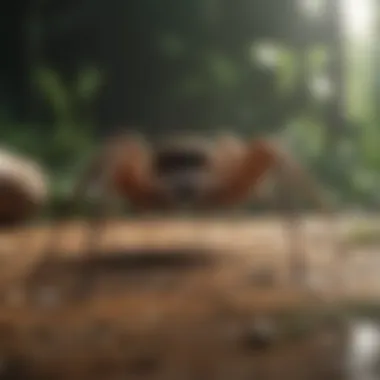Natural Ways to Prevent Spiders in Your Home


Intro
In many homes, spiders often evoke a sense of unease. Understanding how to keep these creatures at bay naturally becomes essential for homeowners. This guide explores various methods that do not rely on harsh chemicals. Instead, it emphasizes eco-friendly strategies to prevent spiders from entering your living space. By modifying your environment and utilizing natural deterrents, you can create a less inviting atmosphere for these arachnids.
Understanding Spider Behavior
Spiders often seek shelter and food in homes. They thrive in undisturbed areas, such as basements and attics. More significantly, the presence of other insects can draw spiders indoors. Recognizing this behavior can aid in developing an effective prevention strategy.
Common house spiders include the common house spider, the cellar spider, and the jumping spider. Each species has unique habits. For example, jumping spiders are more likely to be seen in open spaces. Understanding the types of spiders can help in customizing your approach to control them.
Habitat Modification
One of the primary methods for keeping spiders away is modifying their environment. Here are several actionable steps:
- Declutter: Reducing clutter in your home minimizes hiding spaces for spiders. Focus on areas like basements, attics, and garages.
- Seal Cracks and Gaps: Inspect windows, doors, and walls for cracks. Sealing these openings prevents spiders from entering.
- Manage Outdoor Areas: Keep your yard clean. Trim back bushes and overgrown plants to reduce spider habitats.
Natural Deterrents
Utilizing natural deterrents is another effective strategy. Several substances can repel spiders without harming the environment:
- Essential Oils: Scents like peppermint, tea tree, and lavender can deter spiders. Spraying diluted oils around entry points is beneficial.
- Vinegar: A mixture of vinegar and water can repel spiders. Spray this solution in corners and areas where spiders frequent.
- Garlic: The strong smell of garlic can deter not just spiders, but other insects as well. Crush garlic cloves in water, let it steep, then spray.
"Natural deterrents provide an effective way to keep spiders away without resorting to chemicals."
Maintenance Practices
Maintenance is crucial for long-term prevention of spider infestation. Regular cleaning and inspection can make a significant difference:
- Frequent Cleaning: Regularly vacuuming and dusting removes spider webs and any insects that may attract spiders.
- Check Light Sources: Exterior lighting can attract insects, which in turn attracts spiders. Using yellow sodium vapor lights can help reduce this attraction.
- Regular Inspections: Periodically checking your home for cracks and gaps will help maintain preventive measures.
Closure
Creating a spider-free environment requires effort and consistency. By understanding spider behavior, modifying habitats, using natural deterrents, and maintaining a clean space, you can effectively reduce their presence in your home. This guide aims to equip you with practical tools for a more comfortable living space, free from the disturbance of unwanted spiders.
Understanding Spiders
Understanding the different aspects of spiders is crucial for anyone who seeks to keep these creatures at bay. Knowledge about spiders informs homeowners about the various species they may encounter, their behaviors, and their ecological roles. This knowledge can significantly alter how one perceives spiders, shifting the narrative from one of fear to understanding, which is essential for employing effective natural deterrents.
Spiders’ Role in Ecosystems
Spiders play a vital role in many ecosystems as natural pest control agents. They help regulate insect populations by preying on various bugs, including mosquitoes and flies. In doing so, spiders contribute to maintaining the balance within their habitat. Without spiders, pest populations could explode, leading to problems for crops, gardens, and human health. Thus, appreciating spiders' role can lead to a more balanced perspective. It's important to recognize that while spiders may be unwelcome in homes, they are beneficial in broader ecosystems.
Common Species Found in Homes
In residential settings, certain spider species are more common than others. Recognizing these species is important, not only for identification purposes but also for understanding their behaviors and habitats. Key species include:
Brown Recluse
The Brown Recluse is noted for its violin-like marking on its back, which makes it distinctive. This spider prefers secluded areas, making it more likely to be found in attics, basements, and closets. While primarily a recluse, it can bite if provoked, leading to serious health risks. Thus, identifying its presence can prompt homeowners to take necessary precautions to prevent unwanted encounters. Understanding its behavior can be very helpful when creating safe environments in homes.
Black Widow
The Black Widow is easily recognized by its glossy black body and the red hourglass marking on its abdomen. This spider is known for its potent venom, which poses health risks to humans. Like the Brown Recluse, it enjoys hiding in dark areas like woodpiles or sheds. Awareness of this species is critical for safety and deciding on preventative measures to keep homes spider-free. Its presence may require immediate attention to eliminate or deter it.


Common House Spider
The Common House Spider is often misidentified but poses little threat to humans. It weaves messy webs in corners and is typically harmless. This spider feeds on other insects, thereby serving its ecological role as a pest control agent. While this spider is generally considered beneficial, its sudden overpopulation can still lead to discomfort among residents. Knowing how to manage its presence can help ensure a balanced approach to keeping living spaces spider-free.
Identifying Spider Attractants
Understanding what attracts spiders into your living space is crucial for keeping them away. If you recognize these attractants, you can implement changes to reduce their presence significantly. This section focuses on food sources and shelter preferences that create a hospitable environment for spiders.
Food Sources for Spiders
Spiders are primarily carnivorous. They seek food sources, particularly insects, which are typically prevalent in homes. Common pests such as flies, mosquitoes, and even ants can draw spiders closer. By recognizing where these insects proliferate, you can reduce spider activity indirectly. Regular monitoring of your home for these pest species can lead to quicker preventive measures.
Shelter Preferences
Spiders prefer locations that offer safety and a conducive environment. Two significant types of shelter that attract spiders are dark corners and cluttered areas. Each of these has unique attributes that make them appealing for spiders, and understanding these can aid in mitigating their presence.
Dark Corners
Dark corners are often overlooked during cleaning routines. These areas create a perfect hideaway for spiders due to limited human activity. The absence of light allows spiders to feel safe, limiting their exposure to predators. This characteristic makes dark corners a favorable spot for spiders to weave webs and lay eggs. To minimize this risk, regularly clean these spaces to disrupt any potential spider habitat.
Cluttered Areas
Cluttered areas present another inviting environment for spiders. Items piled up, whether stacks of boxes or clothes, provide plenty of nooks and crannies. These cluttered environments offer not just shelter but also potential food sources, as they may encourage other pests. Regular decluttering is essential to eliminate these spider-friendly zones. Keeping spaces organized reduces both clutter and spider attraction, making your home less appealing for these creatures.
Natural Deterrents
Natural deterrents play a crucial role in keeping spiders away without the need for harmful chemicals. They offer an eco-friendly way to manage spider populations in and around residential spaces. The appeal lies in their effectiveness and the absence of synthetic substances that can harm both humans and the environment. When utilizing natural solutions, it is important to consider the specific methods and substances that are truly beneficial for deterring spiders, as well as their safety and practicality.
Essential Oils as Repellents
Essential oils provide a versatile approach to keeping spiders at bay. Their strong scents are particularly effective in repelling these arachnids, making them a popular choice in natural pest control. Among the various essential oils, peppermint and eucalyptus stand out due to their unique properties.
Peppermint Oil
Peppermint oil is renowned for its potent aroma, which many find refreshing. However, spiders dislike this strong scent. This quality makes peppermint oil a popular option for homeowners seeking to deter these pests. When used in a diluted form, it can be sprayed in corners, nooks, and even around windows and doors. The advantage of peppermint oil lies in its non-toxic nature. There are some considerations, though, such as the necessity for regular application to maintain its efficacy. While many find this oil effective, individual responses can vary depending on the species of spider present.
Eucalyptus Oil
Eucalyptus oil also boasts a strong fragrance that can deter spiders. Its antimicrobial properties add another layer of appeal, providing additional health benefits while keeping spiders at bay. Homeowners often appreciate eucalyptus oil for its ability to blend well with other natural ingredients in pest deterrent recipes. Like peppermint oil, eucalyptus must be reapplied regularly to ensure continued protection against spiders. It may not be as readily available in all households, which can pose a challenge for some. Yet, its effectiveness can make it worth the effort to obtain.
Vinegar Solutions
Vinegar offers an accessible and effective natural solution for spiders. Its acidity is not only a household cleaner but also acts as a deterrent. A simple mixture of equal parts vinegar and water sprayed in spider-prone areas can disrupt a spider's habitat. Additionally, vinegar has antifungal properties, adding further benefit. However, some may find the smell unpleasant, although it usually dissipates after a short period.
Citrus Peels and Other Natural Solutions
Using citrus peels is another method to naturally deter spiders from taking residence in your home. The oils in citrus peels have an odor that is unappealing to spiders.
Lemon Peels
Lemon peels can be strategically placed around the house, especially in corners or entryways. Their refreshing scent, often associated with cleanliness, also serves as a natural spider repellent. Many homeowners find it easy to obtain lemon peels after using lemons for cooking or beverages. The unique feature is that they are biodegradable on disposal, making them an eco-friendly option. However, the effectiveness may wane over time, requiring periodic replacements.
Orange Peels


Similar to lemon peels, orange peels possess properties that can deter spiders. Their strong fragrance can mask the scents that attract spiders, making them an effective repellent. Orange peels are not difficult to source, and they can be a great use for leftover peels after enjoying the fruit. The main disadvantage is that, like lemon peels, their effectiveness diminishes over time and they need replacing to remain effective.
Using these natural deterrents creates an environment less welcoming to spiders, ensuring your home remains a more comfortable place to reside.
Environmental Modifications
Modifying the environment is essential when aiming to reduce spider populations in and around residential areas. By understanding how spiders interact with their surroundings, homeowners can make specific changes to deter these arachnids naturally. Environmental modifications focus on eliminating conditions that favor spider presence. Creating a less inviting habitat can be achieved through a two-pronged approach: improving indoor cleanliness and managing outdoor spaces.
Decluttering Your Space
Clutter is a significant factor that can attract spiders. Items like cardboard boxes, stacks of paper, and piles of clothes provide ample hiding spots. When spaces are not regularly organized, spiders may feel more secure and continue to inhabit these areas. Regularly decluttering can eliminate potential homes for spiders, making less space available for them. Furthermore, keeping floors clear allows for easier cleaning, which can disrupt spider webs and prevent spiders from settling in.
Sealing Entry Points
Preventing spiders from entering a home starts with sealing potential entry points. Small openings, gaps, and cracks can easily allow spiders to invade. Focusing on three critical areas enhances the effectiveness of spider prevention:
Windows
Windows often have gaps around them that spiders can utilize to gain access indoors. The key to effective spider prevention involves ensuring that window screens are intact and free from holes or tears. Good-quality window seals can deter spiders while also improving energy efficiency. However, if the seals are not checked regularly, the gaps can become welcoming entrances for spiders.
Doors
Doors represent another common entry point for spiders. Weatherstripping can be a significant benefit here. Properly sealed doors can prevent many types of pests from entering, including spiders. Keeping doors closed whenever possible also reduces the chance of spiders wandering inside. The downside is that doors must be regularly maintained to ensure the seals stay effective over time.
Cracks and Crevices
Cracks and crevices in walls and foundations provide additional entry points for spiders. Identifying and sealing these gaps is a simple yet effective method for pest control. Materials such as caulk can be used to fill in spaces, particularly around plumbing and electrical lines. The common downside is that some homeowners may overlook these small openings, thinking they are insignificant.
Managing Outdoor Spaces
Proper management of outdoor spaces is another vital element in keeping spiders at bay. It's essential to create an environment that is less attractive to them. This involves:
Trimming Vegetation
Overgrown plants and shrubs can serve as shelters for spiders. By maintaining vegetation through regular trimming, the risk of attracting spiders decreases. Bringing plants back to a manageable size not only improves aesthetic appeal but also minimizes opportunities for spiders to hide.
Creating Barriers
Establishing barriers can further enhance spider prevention. Items such as gravel or stones around the foundation create an inhospitable environment for spiders and other pests. These barriers limit the ability of spiders to reach the home’s base. However, one must consider that barriers must be maintained, as debris can accumulate and create new hiding spots for spiders.
Regular Maintenance Practices
Maintaining a clean and organized environment is crucial in preventing spiders from taking up residence in your home. Regular maintenance practices serve as the first line of defense against these arachnids by minimizing their habitat and food sources. Implementing consistent cleaning routines and preventative measures can significantly lower the likelihood of spider infestations.
Routine Cleaning Strategies
Vacuuming
Vacuuming is an effective method to control spiders and their potential food sources. This cleaning technique removes not only dust and dirt, but also insects, which are primary attractants for spiders. The key characteristic of vacuuming lies in its ability to reach areas where spider webs and egg sacs may be hidden.
Vacuuming is particularly beneficial because it allows you to target specific areas such as corners, behind furniture, and under appliances. This thorough approach reduces nesting spaces, making your home less appealing to spiders. However, care must be taken to dispose of the vacuum bag or contents outside promptly to prevent re-infestation.
Wiping Surfaces


Wiping surfaces is another critical aspect of regular cleaning. This practice involves cleaning countertops, shelves, and other surfaces to eliminate any remaining crumbs or residues that may attract insects, the primary food source for spiders. The unique feature of wiping is that it helps maintain a polished and hygienic appearance in the home, adding to the overall ambiance.
Regularly wiping surfaces is not only beneficial for keeping spiders at bay but also improves indoor air quality. However, keep in mind that some surfaces may require specific cleaning agents, so it’s essential to choose the right products to avoid damaging them.
Implementing Preventative Measures
Periodic Inspections
Periodic inspections can play a significant role in spider prevention. By routinely checking your home for signs of spiders, such as webs or shed skins, you can take immediate action before they become a larger problem. The key characteristic of these inspections is their proactive nature, allowing you to catch potential infestations early.
Performing systematic inspections is beneficial because it helps identify areas that need enhancement or additional cleaning. However, some may find this task tedious, so integrating it into your regular cleaning schedule can address this challenge.
Outdoor Maintenance
Outdoor maintenance is essential to limiting spider access to your home. Keeping your garden tidy and trimmed can prevent spiders from using outdoor vegetation as a bridge to enter your home. This maintenance not only improves aesthetic appeal but also lowers the risk of attracting pests.
Regular yard work, such as trimming shrubs and removing debris, is a valuable strategy, as it limits the humidity and meets less stable spots where spiders might thrive. The downside is that outdoor maintenance requires time and sometimes, physical effort, but the long-term benefits outweigh these costs.
When Natural Methods Fall Short
Despite diligent efforts employing natural deterrents and environmental modifications, some individuals may still find themselves battling persistent spider populations. Recognizing when these methods are insufficient can guide homeowners toward more effective solutions. The importance of this topic lies in understanding that while natural approaches are valuable, they may not always yield the desired results, particularly in severe infestations.
When natural methods falter, it underscores the necessity to assess other viable options. Professionals in pest control can provide targeted solutions, ensuring a comprehensive approach to managing unwanted guests. In addition, it is essential that homeowners grasp the implications of various treatment options—including their limitations and possible repercussions.
Assessing Professional Pest Control Options
When natural methods fail, contacting professional pest control becomes a practical choice. Experts possess not only the knowledge but also the tools necessary for effective spider elimination. They conduct thorough inspections to identify problem areas and recommend treatments tailored to specific situations. This might involve chemical and non-chemical solutions, depending on the individual case.
When engaging professional services, consider the following factors:
- Reputation: Look for companies with positive reviews and proven track records.
- Certifications: Ensure the company is appropriately licensed and insured to operate in your area.
- Methods Used: Ask about the techniques they implement, focusing on eco-friendly and humane treatments if this is a concern.
Understanding the Risks of Chemical Treatments
Utilizing chemical treatments when natural methods fall short invites various considerations. Chemicals might provide a speedy resolution to spider problems, but they often come with risks. Potential hazards include environmental impacts, human health effects, and harm to beneficial insects. It is crucial to weigh immediate benefits against these possible consequences.
Key points to keep in mind when considering chemical treatments include:
- Health Concerns: Children and pets are particularly vulnerable to toxic chemicals. Ensure you understand safety measures to mitigate exposure.
- Environmental Impact: Chemicals can disturb local ecosystems. They may unintentionally harm non-target organisms, leading to broader ecological repercussions.
- Long-Term Efficacy: Many chemical treatments provide only temporary relief. Spiders may return if underlying conditions that attracted them are not addressed.
"Chemical treatments may solve immediate issues, but could create larger problems for your home's ecosystem."
Concluding Thoughts
Understanding how to effectively keep spiders away naturally is crucial for many homeowners. These eight-legged creatures can easily turn into uninvited guests in our living and working spaces. This article provided valuable insights into natural methods that can help maintain a spider-free environment. With practical strategies discussed, readers are now equipped with tools to safeguard their spaces without relying on chemical pesticides.
Evaluating Long-Term Strategies
A key consideration is that natural methods require commitment. Implementing strategies such as regular cleaning and environmental modifications can be time-consuming. However, maintaining a consistent routine can be massively beneficial. When homeowners regularly assess their living conditions, they reduce the likelihood of spiders making a return. This evaluation process also includes examining the exterior of the home, looking for potential entry points.
Benefits of Long-Term Approaches:
- Less Frequent Visits from Spiders: By maintaining a clean home, you can minimize spiders that are attracted to potential food sources and shelters.
- Environmental Health: Using natural mixtures keeps your home safe for children and pets, offering peace of mind.
- Cost-Effective: Over time, the savings from not purchasing chemical treatments add up.
Creating a Balanced Approach
Creating a balanced approach involves understanding that not all spider encounters are alarming. Many spiders play vital roles in controlling pests. Hence, a homeowner's goal should not be eradication but deterrence and coexistence. This means combining various methods from habitat modification to employing natural deterrents.
- Active Prevention: Using essential oils or vinegar mixtures can be effective, but their use must be regular. Freshly applied substances ensure ongoing effectiveness.
- Understanding the Environment: Recognizing the natural predators of spiders can also assist. Certain birds and other insects contribute beneficially to pest control.
- Focused Attention on Outdoor Spaces: By managing your yard, trimming vegetation, and clearing debris, one can create an environment less appealing to spiders. This outdoor management often extends the effectiveness of indoor strategies.















